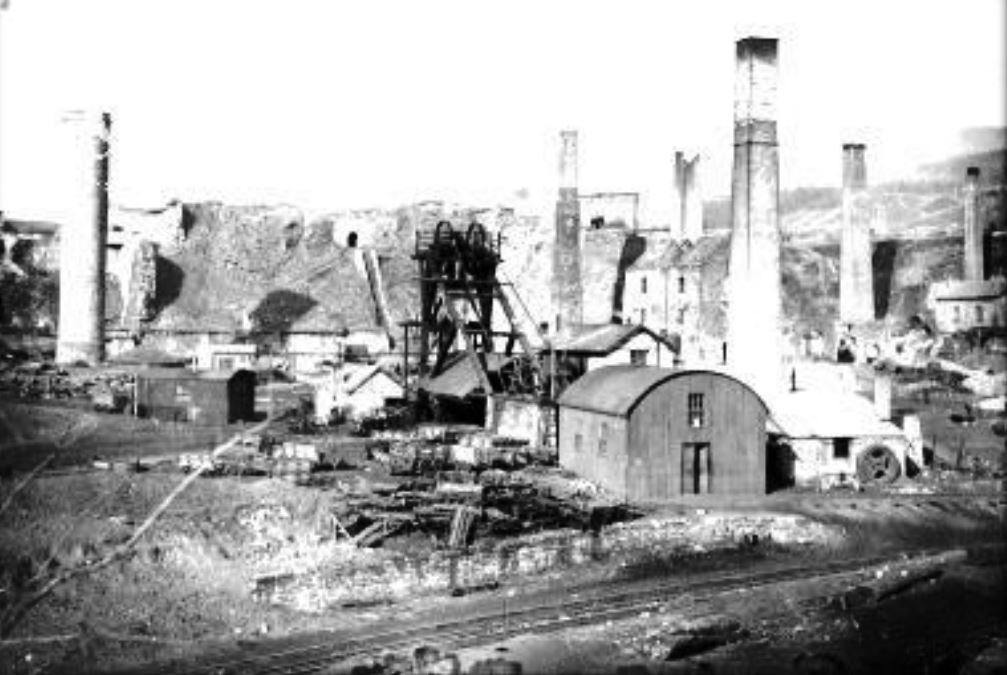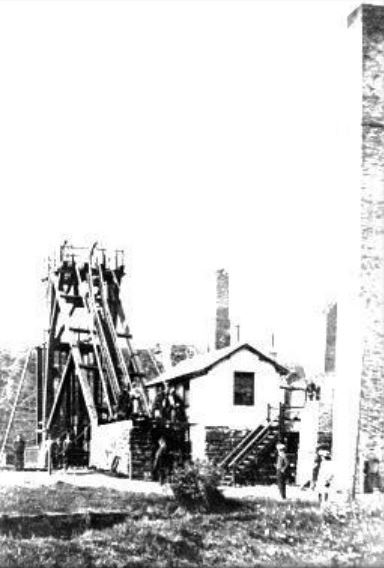 Aberdare, Cynon Valley (00880344)
Aberdare, Cynon Valley (00880344)
The River Level Pit was in the grounds of the old Abernant Iron Works and was sunk to the Gellideg seam which it found at a depth of 98.55 metres. The shaft measured 17 feet by 11 feet. It was worked in 1878 by the Aberdare Plymouth Company when it was managed by a Mr. Hughes.
On Monday, 19th of November 1893, fourteen-year-old Phillip Thomas was working with his father and brother at the coalface, when he was told to fetch some ramming. He took a long time fetching it so his father gave him a good talking too. Phillip then up and ran away leaving his coat and vest behind. His brother chased after him but lost him in old workings. They were uncertain whether he had come up the pit so a full search was made of all the workings and work on the Tuesday stopped altogether so the men could help in the search. Meanwhile, the father went to Cardiff docks in the belief that his son may have gone there. Back at the pit even the dirt in the gobs was sifted through in case he was under a fall, but to no avail. On Wednesday night the men search the nearby mountains but again the search yielded nothing. With the men reluctant to go back to work until he was found, the management again agreed to an underground search on the Thursday and found near the place where it all started. Apparently, he often spotted the searchers but backtracked so that he was behind them.
In 1896 it was managed by Rees Howells and owned by the Aberdare Works and Collieries Company who employed 283 men underground and 31 men on the surface of this mine. Around that time it was working the No.2 Yard and Gellideg seams by the pillar & stall method using naked lights. Ventilation was by a furnace.
In 1897 it was served by the Taff Vale Railway and had a sidings capacity for 17 full wagons and for 17 empty wagons, so it wasn’t a very big concern. In 1908 it employed 19 men on the surface only. It is not listed in 1913, but in 1916 it employed 425 men with W. Eynon as the manager.
In 1917 it is shown to be in the hands of the Powell Duffryn Steam Coal Company Limited. In 1918 it employed 370 men underground and 67 men on the surface with W. Eynon still as the manager. This company was a member of the Monmouthshire and South Wales Coal Owners Association. In 1923 it was managed by M. Gulliver and employed 879 men working underground and 74 men working at the surface of the mine.
In 1930 it employed W. Moore as the manager and employed 949 men working underground and 119 men at the surface. In 1934 there were 110 men working at the surface of the mine and 920 men working underground producing 300,000 tons of coal. In 1938 it employed 808 men with the manager being J.T.B. Wellbourn. It closed as a production unit in 1940.
In 1934 the Powell Duffryn Company was based at 1, Great Tower Street, London with the directors being; Edmund Lawrence Hann, Sir Leonard Brassey, Charles Bridger Orme Clarke, William Reginald Hann, Norman Edward Holden, Lord Hyndley, Sir Stephenson Hamilton Kent, Sir Francis Kennedy McClean and Evan Williams. The company secretary was Alfred Read. At that time it employed 15,260 men working in sixteen collieries who produced 4,780,000 tons of coal.
By Nationalisation in 1947 there were only 6 men underground and 2 men on the surface on pumping operations. Amongst the seams worked at this colliery were the Seven-Feet and Nine-feet seams. In this area of the Cynon Valley, there were twelve workable seams between the bottom lying Gellideg seam and the higher Two-feet-Nine seam. Spread through a vertical thickness of around 375 feet they totalled 46.5 feet, giving an average thickness per seam of 3 feet 10 inches.
The coals were classed as type 202 and type 203 Coking Steam Coals, weak to medium caking, low volatile, low ash and low sulphur coals. They were used for steam raising in boilers for ships, locomotives etc., and for foundry and blast furnace coke.
At about 3.45 p.m. on the 9th of December 1896, an inrush of water occurred at this colliery and six men and boys lost their lives by drowning. The remaining 120 men either made their way out or were rescued uninjured within two hours of the first alarm. Those that lost their lives were:
- George Evans, aged 14 years;
- John Jenkins, aged 52 years;
- Thomas Jenkins, aged 14 years
- Thomas Jones, aged 29 years;
- J. Phillips, aged 29 years;
- John Williams, aged 13 years.
The newspapers reported:
A short time before the day shift at the River level, Abernant, South Wales, ceased working on Wednesday, an inrush of water occurred in the Gellydeg seam, where about 120 men were engaged. A terrible scene followed, as the seam has considerable dip the water rushed down with great force, and the men had great difficulty in effecting an escape. Many had to walk several yards through the water neck deep. Ultimately all but five or six men reached the surface in safety. Little hope was entertained that those still in the pit would be saved. Numerous cases of bravery are reported. Boys and men of short stature had to be carried by their taller comrades to prevent them from being drowned. The release of the six miners entombed…is today regarded as hopeless. The diver who went down has found it impractical to carry out the proposed search for the men.
During the investigation into the disaster no blame was attached to the officials at the River Level Pit, but it was found that the Ysguborwen pit has worked further than they should have and had encroached into the River Level pits take in 1872. Unknowingly the River Level officials thought that the barrier was wide enough to contain the water and that they could work a little further, when in fact it came down to two or three feet when the water broke through. Although the investigators thought that management at Ysguborwen should be prosecuted, they added; “I am informed that it would be difficult to obtain a conviction because the recklessness shown is so common in mining.” The full report can be found here.
 Just some of the fatalities at this mine:
Just some of the fatalities at this mine:
- 3/10/1853, Lewis Griffiths, aged 52, collier, fall of coal
- 28/6/1854, David Griffiths, aged 15, haulier, fall of roof.
- 3/2/1869, John James, aged 14, collier, fall of roof.
- 9/4/1869, Daniel Matthews, aged 16, collier, fall of roof.
- 15/10/1873, Thomas Davies, aged 22, collier, shotfiring incident
- 30/9/1879, William Bowen, aged 30, collier, fall of roof.
- 13/1/1880, Nicholas Williams, aged 39, collier, fall of roof.
- 15/3/1880, Thomas Jones, aged 19, collier, fall of roof.
- 8/6/1880, Benjamin Morgan, aged 19, collier, explosion of gas.
- 1/3/1881, Evan Jones, aged 22, collier, fall of roof.
- 3/5/1882, William Rowbury, aged 34, haulier, explosion of gas.
- 8/1/1886, D.J. Williams, aged 12, collier boy, explosion of gas.
- 8/7/1887, John Meredith, aged 45, collier, fall of roof.
- 30/4/1888, Thomas Morgan, aged 45, labourer, fall of roof.
- 8/2/1890, William Williams, aged 64, collier, fall of roof.
- 13/5/1891, David Jones, aged 27, rider, crushed by shaft cage.
- 2/12/1892, Job Thomas, aged 41, collier, fall of roof.
- 28/2/1893, Thomas Edmunds, aged 51, collier, shotfiring incident.
- 12/9/1893, Alfred Williams, aged 33, collier, fall of roof.
- 9/12/1896, John Williams, aged 13, collier, drowned.
- 9/12/1896, John Phillips, aged 29, collier, drowned.
- 9/12/1896, Thomas Jones, aged 29, collier, drowned.
- 9/12/1896, John Jenkins, aged 52, collier, drowned.
- 9/12/1896, Thomas Jenkins, aged 14, collier, drowned.
- 9/12/1896, George Evans, aged 14, drowned.
- 14/1/1897, Daniel Evans, aged 23, collier, fall of roof.
- 14/7/1927, Richard James, aged 23, blacksmith’s striker, fell.
- 15/8/1927, Samuel Hawkins, aged 39, rider, crushed by trams.
- 12/2/1929, James Dalby, aged 34, collier, fall of roof.
- 27/11/1929, Benjamin Edwards, aged 50, rider, crushed by trams.
Some statistics:
- 1889: Output: 73,434 tons.
- 1894: Output: 77,717 tons.
- 1896: Manpower: 314.
- 1908: Manpower: 19.
- 1916: Manpower: 425.
- 1918: Manpower: 437.
- 1920: Manpower: 650.
- 1923: Manpower: 953.
- 1924: Manpower: 1,049.
- 1925: Manpower: 1,000.
- 1927: Manpower: 849.
- 1930: Manpower: 1,068.
- 1931: Manpower: 800.
- 1932: Manpower: 934.
- 1933: Manpower: 1,100.
- 1934: Manpower: 1,030. Output: 300,000 tons.
- 1938: Manpower: 808.
- 1940: Manpower: 70.
- 1941: Manpower: 16.
- 1942: Manpower: 12.
- 1944: Manpower: 11.
Information supplied by Ray Lawrence and used here with his permission.
Return to previous page
